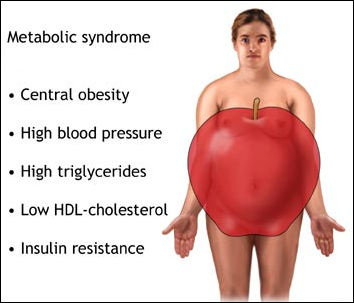Persistent
Detectable HIV Viral Load Is Linked to Metabolic Syndrome
 |
 |
 |
 |
 |
 |
 |
| SUMMARY:
HIV patients who do not maintain a viral
load below the level of detection with antiretroviral
therapy (ART) are more likely to develop
metabolic syndrome -- and therefore may
be at higher risk of cardiovascular disease
-- according to an Italian study published
in the December
2009 Journal of Acquired Immune Deficiency
Syndromes. |
|
 |
 |
 |
 |
 |
 |
 |
By
Liz Highleyman
A growing body of evidence indicates that ongoing
HIV replication can cause problems throughout the
body, well before the risk of opportunistic
illness rises due to extensive immune system damage.
Many
people with HIV
have features of the metabolic
syndrome, characterized by abnormal blood lipid
levels (high triglycerides and low HDL or "good"
cholesterol), insulin resistance, high blood pressure,
and abdominal obesity -- all risk factors for cardiovascular
disease. However, it is not clear whether this is
related to chronic HIV infection itself, antiretroviral
drugs, traditional risk factors, or some combination
of factors.

Nicola
Squillace from the University of Modena and Reggio
Emilia and colleagues conducted a study to evaluate
the association between HIV viral load and metabolic
syndrome in a cohort of HIV
positive patients.
The
retrospective cross-sectional analysis included 1324
consecutive patients receiving stable ART
regimens who were seen at a university clinic
between January 2006 and January 2008. A majority
(63%) were men and the mean age was about 45 years.
Results
 |
In a univariate (single variable) analysis, the
following factors were significantly associated
with metabolic syndrome: |
| |
 |
Older
age: mean 47 years for patients with metabolic
syndrome vs 44 years for those without (P
< 0.0001); |
 |
Male
sex: 69% with metabolic syndrome vs 61%
without (P = 0.009); |
 |
Apolipoprotein
B (ApoB): 111.51 vs 100.57 mg/dL, respectively
(P < 0.0001); |
 |
Insulin
resistance: median HOMA-IR score 5.14 vs
2.95, respectively (P < 0.0001); |
 |
Higher
body mass index: 25.17 vs 22.80, respectively
(P < 0.0001); |
 |
Current
protease inhibitor use: 62% vs 53%, respectively
(P = 0.006); |
 |
HIV
viral load: 2.17 vs 2.02 log10, respectively
(P = 0.0048). |
|
 |
About
one-third of people with HIV RNA > 400 copies/mL
had metabolic syndrome, compared with about one-quarter
of those with < 400 copies/mL. |
 |
In
a multivariate analysis adjusting for potential
confounding, the following factors remained significant
predictors of metabolic syndrome: |
| |
 |
HIV
viral load: odds ratio (OR) 1.25 per log,
or 25% higher risk (P = 0.003); |
 |
Older
age: OR 1.60 per 10-year increment (P <
0.0001); |
 |
Insulin
resistance: OR 2.77 -- nearly 3 times the
risk -- if HOMA-IR > 3.8 (P <
0.0001). |
|
Based
on these findings, the investigators concluded, "Persistent
viremia is a significant predictor for the development
of metabolic syndrome."
They
added, "Viral control through effective antiretroviral
therapy is paramount not only for the control of HIV
disease progression but also for the prevention of
metabolic syndrome and associated cardiovascular disease."
Department
of Medicine and Medical Specialties, Infectious Diseases
Clinic, University of Modena and Reggio Emilia, Modena,
Italy.
12/11/09
Reference
N Squillace, S Zona, C Stentarelli, and others.
Detectable HIV Viral Load Is Associated With Metabolic
Syndrome. Journal of Acquired Immune Deficiency
Syndromes 52(4): 459-464 (Abstract).
December 2009.